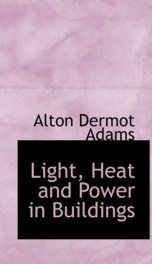light heat and power in buildings

LIGHT, HEAT AND POWER IN BUILDINGS - PREFACE - In this volume the object is to present in, compact form the main facts on which selection of the sources for light, heat and power in buildings should be based. The problem for which a soIution is sought is to determine the kind of equipment that will yield the service required in any case at the least , total cost. Such a purpose leaves little room for discussions of theory relating to any partic tlarc lass of apparatus, which has , already been done. in separate and larger volumes. It follows that the only novelty to be expected here is that of arrangement, by which the costs of service from widely dif ferent sources are set down side by side. Should this arrangement prove convenient for those charged with the selection of apparatus for light, heac and power, the labor spent on the following pages will have accomplished its purpose. ALTON D. ADAMS. Copyright ALTON D. ADA IS, M. E. IWl. CON TS. Chapter I.-Cost of heat, light and power from public gas and electrical supply and from coal. Costof lightfrom gas and electrical supply. Cost of heat from gas and electrical supply. Cost of power from steam plant and from gas. Cost of power from electrical supply. Efficiency, heating effect and required labor with motors and engines. Bages ........................... .9-13 Chapter 11.-Gas, electricity, steam land hot water in the distribution of heat, light and power. Gas , as a means of illumination. E. lectricity for illumination. Distribution , of heat by gas. Distribution of heat by air, steam and hot water. Distribution of power by gas, electricity, belts and shafting and by steam. Conclusions ....................................... . 1 5-30 Chapter 111.-Advantages of the combined production of light, heat and power from steam. Light, heat and power from a single plant. Fuel required with boilers for light, heat and power. Heat from exhauststeam. Power and heating with given amount , of steam. Heating and illumination with given amount of steam. Times , of demand for light and heat.. ... . 31-39 Chapter IV.-Efficiency in production and distribution of heat, light and power frmom hot water and steam. Efficiency of heating by hot water. Efficiency of heating by steam. C0rnbine. d efficiency of engines and boilers. Combined e. ff iciency of boilers, engines, dynamos, wiring and electric motors. Combined efficiency of boilers engines, dy namos, wiring and lamps. Combined efficiency 3 5 . from boilers to electric heaters.. ................. . 4 0 4 6 Chapter v-Genexal requirements and safety of boilers. Explosive energy. Importance of safe and efficient boilers. Sources of danger in boilers. Conditions of safety in boilers ................................ .. 47-52 CONTENTS. t Chapter V1.-Boiler capacity. Measures of boiler capacity. Horse power of boilers. Heat required for feed water. Relations between heating and grate surfaces land the capacities of . boilers. Rules to and heating surfaces of boilers. Water evaporated by each aquare foot of heating surface ................... .53-69 I Chgptex VI1.--Combustion of fuels and boiler efficiency. Possible efficiency. Pounds of water evaporated. Sources of loss with boilers. Losses from wet fuel. Losses from imperfect combustion of carbon. Losses - of volatile matter. Losses due to the temperature of chi, mney gases. Air required for combustion. Specific heats of gases. Temperature resulting from the combustion of carbon. Heat passing to the boiler surfaces by radiation and from the gases of combustion. Heating p0we. r of semi-bituminous coal. Amount of air required for perfect combustion. Initial temperature of combustion .................. .70-86 Z Chapter VII1... --This text refers to an alternate Paperback edition.
Info about the book
Author:
Series:
Unknown
ISBN:
1931498121
Rating:
4.5/5 (1)Your rating:
0/5
Languge:
English
Users who have this book
Users who want this book
What readers are saying
What do you think? Write your own comment on this book!
write a commentif you like light heat and power in buildings try:
Other books by this author
Do you want to exchange books? It’s EASY!
Get registered and find other users who want to give their favourite books to good hands!


